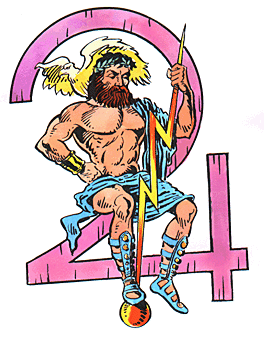The Planet, Jupiter
Jupiter (Iuppiter, Juppiter) or Jove, King of the Roman gods (fifth planet from the sun).

His name is appropriate for our largest planet. A traditional sign for his lightning bolt gives the planet its symbol.

- He was the ancient Italian Father or Lord of Heaven and provider of fertilizing rains giving him another name: Jupiter Pluvius.
- He gave day and night to mankind, sent the snow and the rain, and caused the winds to blow and the dark storm clouds to gather.
- The lightning with the crash of thunder that followed was but an expression of his anger.
- He was the supreme god of the Romans who gradually became identified with the Greek god Zeus.
- Jupiter was thought to be the lord of life, light, and aerial phenomena.
- Although, like Zeus, he was lord of life and death, unlike Zeus he was not controlled by the Fates or Moirae.
- He still determined the course of human affairs and made known the future through the flight of birds and other signs in the heavens.
- Jupiter is the greatest of the planets the largest body in the solar system except the sun.
- His planet is the fifth in order from the sun and the brightest, and it is considered to be the royal planet and ruler of the zodiacal mansion Sagittarius.
- We get “jovial” from the word Jove, one of the forms of the name Jupiter, which means “born under the lucky planet, Jupiter, and therefore happy and healthy.”
- Thursday came to us in its present form from Old English meaning Thor’s Day, and was adapted from the Late Latin of Jupiter’s Day because Thor and Jupiter represent very similar powers.
- Since Jove is another form of Jupiter, it is easy to see how the French jeudi, the Italian giovedi, and the Spanish jueves have continued to preserve the term Jupiter’s Day for the fifth day of the week.
A few scientific facts about Jupiter:
- Master of its orbit, the fifth planet holds a faint ring system and at least sixteen moons in its gravitational grip.
- Four moons are as big as small planets.
- The combined pulls of Jupiter and the Sun also keep two asteroid groups, called the Trojans, in Jupiter’s orbit.
- One group moves along a sixth of the way ahead of Jupiter, the other equally far behind.
- They bear heroes’ names from the ancient Trojan War; the first group represents Greece, the second Troy.
- Jupiter’s tiny outer moons may be Trojan asteroids, trapped when they strayed too close to the planet.
- The evidence comes from photos of the Valles Marineris taken by the Viking 1 orbiter (launched in 1975 and reaching Mars on July 20, 1976).
- As heavyweight champion of the worlds, Jupiter accounts for more than two-thirds of all material in the Solar System outside the Sun.
- It would take 318 Earths to equal Jupiter’s huge mass.
- Gravity two and a half times stronger than our own creates intense pressures in the swirling gases of its atmosphere.
- Scientists think electrical currents on Jupiter may create its giant magnetic field, which extends past the orbits of several of its moons.
- Jupiter’s four largest moons: Io, Europa, Ganymede, and Callisto were discovered by Galileo on January 7, 1610.
- Some astronomers refused to believe Galileo’s claim because they felt that the Solar System with its seven “planets” was complete and they were very upset that an age-old belief could be wrong.
- As stated previously in the list under planets, the ancients thought that the seven planets (Sun, Moon Mercury, Venus, Mars, Jupiter, and Saturn) were complete and that there were no other planets (or moons).
- Eventually, even Galileo’s bitterest enemies had to admit that Jupiter had moons.
- Measuring 5 276 kilometers in diameter, Ganymede is Jupiter’s and the Solar System’s biggest moon.
 You may return to the page of planet images from here.
|


 You may return to the page of planet images from here.
You may return to the page of planet images from here.